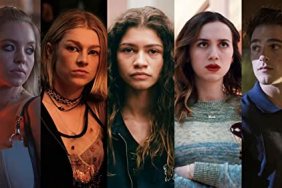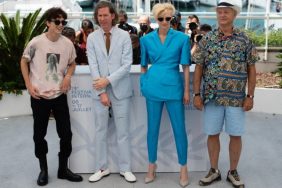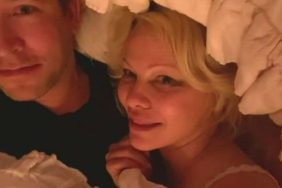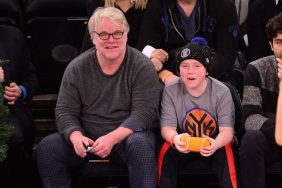Artwork: Hurvin Anderson, Maraval Side Street (2015).
James Baldwin observed, “Artists are here to disturb the peace,” and we are blessed for this. Were it not for artists, we might not stop and simply pause, taken in an experience so visceral it goes beyond words. But then, yes, the urge to translate often comes, and so we give voice to it.
Also: Secret Histories | The Real South Africa, as Seen by the Man They Called “Kitty”
Is It Okay To Be Black? is the title of British artist Hurvin Anderson’s work. It’s a beautiful image of a wall at the barbershop. Floating on a sea of turquoise we see images of Marcus, Martin, and Malcolm, even a young Ali in there, all images pinned to the wall above the tonics, brushes, and lotions lining the counter. It’s a perfect image of a place that more than a few black men the world over know so very well.

Hurvin Anderson, Is It Ok To Be Black (2016)
So then that question, it’s not for folks who sit in the chair, but for the outsiders looking in. For folks who wouldn’t know who Marcus is, even after I say “Garvey.” Cause if you know, then there’s no question to ask. But if you don’t, you might wonder, Why are people so hateful? Is it guilt, shame—or something else? In the United States, the answer to these questions is a matter of life and death. Every day we are reminded by what happens when complacency prevails.
Anderson’s work shows us the importance of representation and the preservation of our shared history, remembering freedom is something you must take by any means necessary. Born in Birmingham to parents of Jamaican origin, Anderson’s work straddles multiple worlds, floating between his native country and his island roots, exploring the levels of identity, belonging, and home. He moves between his subjects with ease and flow. Now a selection of his works are on view in presents Hurvin Anderson: Dub Versions, at New Art Exchange, London, now through September 18, 2016.

Hurvin Anderson, Babershop (2006).
Is It Okay To Be Black? Resides at the heart of the show, the first time it is on view to the public as part of the 70th anniversary of the Arts Council Collection. Here Anderson returns to one of his favorite locales, the barbershop. He honors this space, a space that was built by black folk for black folk when new Caribbean immigrants arrived in the 1950s. This cottage industry has become one integral to the community, and you can see it wherever you look, from Brooklyn to Accra, from Lagos to London. The power of entrepreneurialism is an investment in the community, providing a space where black men gather to talk freely among themselves, liberated from the oppression underlying double consciousness that whiteness demands.
With Dub Versions, Anderson brings us deep into his world, into life in the 1970s and ‘80s growing up in Birmingham’s African-Caribbean community and time spent living in Trinidad as an artist in residence, sharing not only his finished pieces but a panoply of materials from the image making process including preparatory paintings, collages, drawings, and photographs giving us an intimate glimpse into the soul of the artist. The exhibition also includes work from his Grafting series, based around childhood memories of his older brother scrumping for fruit, whether climbing mango trees in Jamaica or apple trees in the Midlands. Ultimately, Anderson reminds us, it’s a matter of character.

Hurvin Anderson, Grafting (2015).
All artwork: Courtesy of the artist and Thomas Dane Gallery, London.
Miss Rosen is a New York-based writer, curator, and brand strategist. There is nothing she adores so much as photography and books. A small part of her wishes she had a proper library, like in the game of Clue. Then she could blaze and write soliloquies to her in and out of print loves.






